oil Seat Exeo 2010 Owner's Guide
[x] Cancel search | Manufacturer: SEAT, Model Year: 2010, Model line: Exeo, Model: Seat Exeo 2010Pages: 319, PDF Size: 9.64 MB
Page 257 of 319
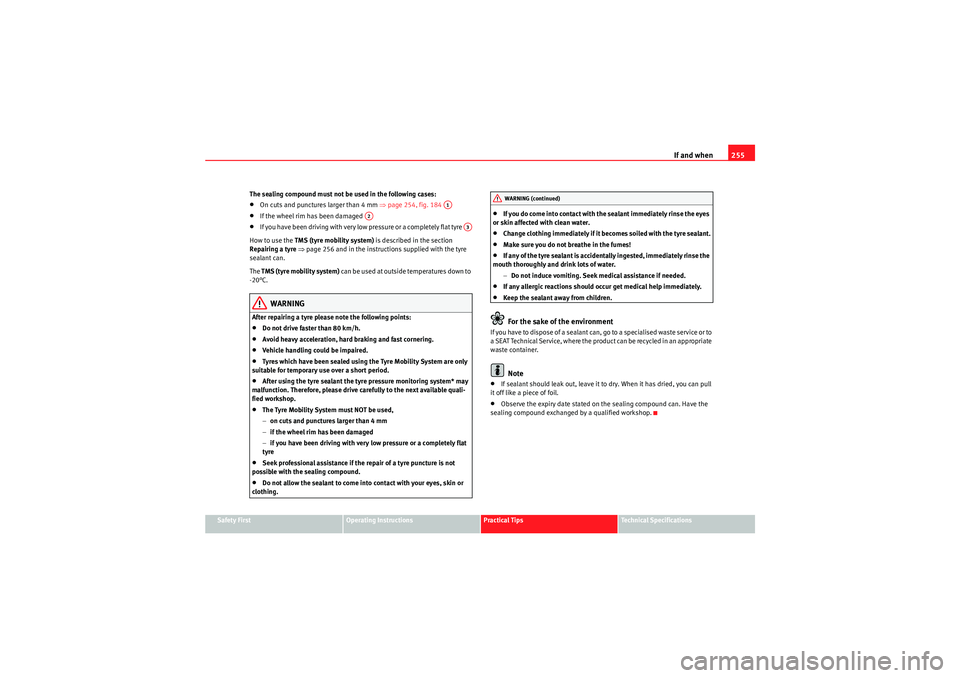
If and when255
Safety First
Operating Instructions
Practical Tips
Technical Specifications
The sealing compound must not be used in the following cases:
•On cuts and punctures larger than 4 mm
⇒page 254, fig. 184 •If the wheel rim has been damaged •If you have been driving with ver y low pressure or a com pletely flat tyre
How to use the TMS (tyre mobility system) is described in the section
Repairing a tyre ⇒ page 256 and in the instructions supplied with the tyre
sealant can.
The TMS (tyre mobility system) can be used at outside temperatures down to
-20°C.WARNING
After repairing a tyre please note the following points:•Do not drive faster than 80 km/h.•Avoid heavy acceleration, hard braking and fast cornering.•Vehicle handling could be impaired.•Tyres which have been sealed using the Tyre Mobility System are only
suitable for temporary use over a short period.•After using the tyre sealant the tyre pressure monitoring system* may
malfunction. Therefore, please drive carefully to the next available quali-
fied workshop.•The Tyre Mobility System must NOT be used,
− on cuts and punctures larger than 4 mm
− if the wheel rim has been damaged
− if you have been driving with very low pressure or a completely flat
tyre•Seek professional assistance if the repair of a tyre puncture is not
possible with the sealing compound.•Do not allow the sealant to come into contact with your eyes, skin or
clothing.
•If you do come into contact with the sealant immediately rinse the eyes
or skin affected with clean water.•Change clothing immediately if it becomes soiled with the tyre sealant.•Make sure you do not breathe in the fumes!•If any of the tyre sealant is accidentally ingested, immediately rinse the
mouth thoroughly and drink lots of water.
−Do not induce vomiting. Seek medical assistance if needed.•If any allergic reactions should occur get medical help immediately.•Keep the sealant away from children.For the sake of the environment
If you have to dispose of a sealant can, go to a specialised waste service or to
a SEAT Technical Service, where the product can be recycled in an appropriate
waste container.
Note
•If sealant should leak out, leave it to dry. When it has dried, you can pull
it off like a piece of foil.•Observe the expiry date stated on the sealing compound can. Have the
sealing compound exchanged by a qualified workshop.
A1
A2
A3
WARNING (continued)
exeo_EN.book Seite 255 Montag, 30. August 2010 4:45 16
Page 258 of 319
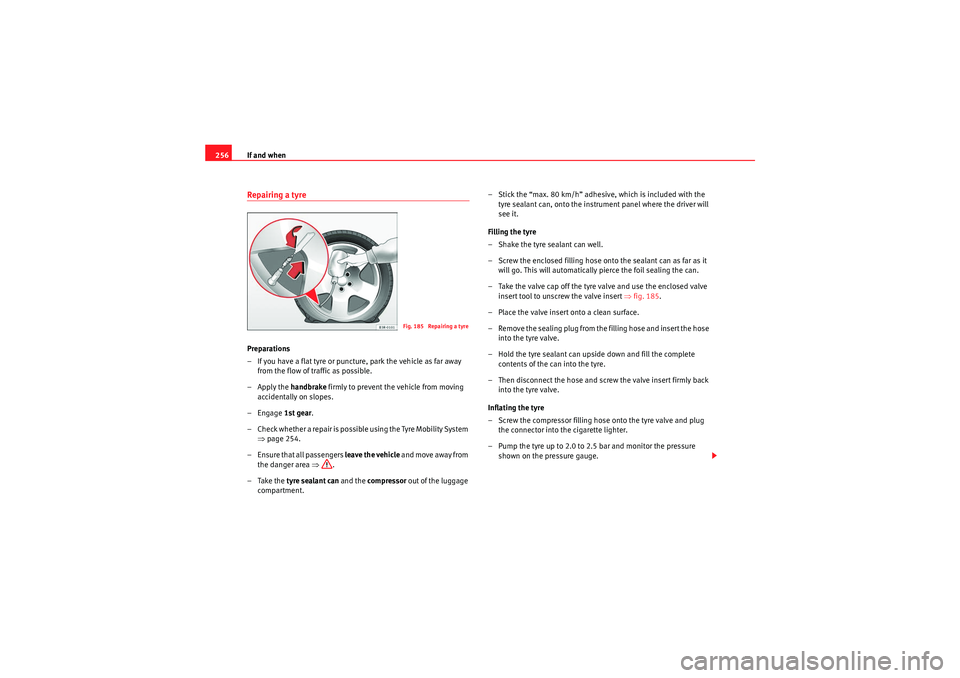
If and when
256Repairing a tyrePreparations
– If you have a flat tyre or puncture, park the vehicle as far away
from the flow of traffic as possible.
–Apply the handbrake firmly to prevent the vehicle from moving
accidentally on slopes.
–Engage 1st gear.
– Check whether a repair is possible using the Tyre Mobility System ⇒page 254.
– Ensure that all passengers leave the vehicle and move away from
the danger area ⇒.
–Take the tyre sealant can and the compressor out of the luggage
compartment. – Stick the “max. 80 km/h” adhesive, which is included with the
tyre sealant can, onto the instrument panel where the driver will
see it.
Filling the tyre
– Shake the tyre sealant can well.
– Screw the enclosed filling hose onto the sealant can as far as it will go. This will automatically pierce the foil sealing the can.
– Take the valve cap off the tyre valve and use the enclosed valve insert tool to unscrew the valve insert ⇒fig. 185 .
– Place the valve insert onto a clean surface.
– Remove the sealing plug from the filling hose and insert the hose into the tyre valve.
– Hold the tyre sealant can upside down and fill the complete contents of the can into the tyre.
– Then disconnect the hose and screw the valve insert firmly back into the tyre valve.
Inflating the tyre
– Screw the compressor filling hose onto the tyre valve and plug the connector into the cigarette lighter.
– Pump the tyre up to 2.0 to 2.5 bar and monitor the pressure shown on the pressure gauge.
Fig. 185 Repairing a tyre
exeo_EN.book Seite 256 Montag, 30. August 2010 4:45 16
Page 259 of 319

If and when257
Safety First
Operating Instructions
Practical Tips
Technical Specifications
– If the tyre pressure remains lower than the value specified above
drive the vehicle approx. 10 metres forwards or backwards, so
that the sealant can spread evenly in the tyre. If the pressure is
still lower than the specification the tyre is too badly damaged
and cannot be repaired using the tyre sealant.
Final check
– After about 10 minutes, stop to check the tyre pressure.
– If tyre pressure is less than 1.3 bar, the tyre is too badly damaged. Do not drive on! You should obtain professional
assistance.
WARNING
•If you have a puncture in heavy traffic, switch on the hazard warning
lights and place the warning triangle in a visible location. This is for your
own safety and also warns other road users.•Make sure your pass engers wait in a safe place ( for instance behind t he
roadside crash barrier).•Please observe the manufacturer’s safety notes on the compressor and
the instructions supplied with the tyre sealant can.•If it is not possible to build up a tyre pressure of 2.0 bar within 6
minutes this means that the tyre is too badly damaged. Do not drive on!•Seek professional assistance if the repair of a tyre puncture is not
possible with the sealing compound.•If tyre pressure is less than 1.3 bar after driving about 10 minutes, the
tyre is too badly damaged. Do not drive on! Obtain technical assistance.Caution
Take special care if you have to repair a tyre on a slope.
Note
•Do not use the compressor for longer than 6 minutes. Otherwise, it might
overheat. When the compressor has cooled down, you can use it again.•If tyre sealant should leak out, leave it to dry and then pull it off like foil.•After carrying out a tyre repair remember to buy a new tyre sealant can at
a qualified workshop. This will ensure that the Tyre Mobility System is opera-
tive again.•Please observe legal requirements when doing so.
exeo_EN.book Seite 257 Montag, 30. August 2010 4:45 16
Page 297 of 319
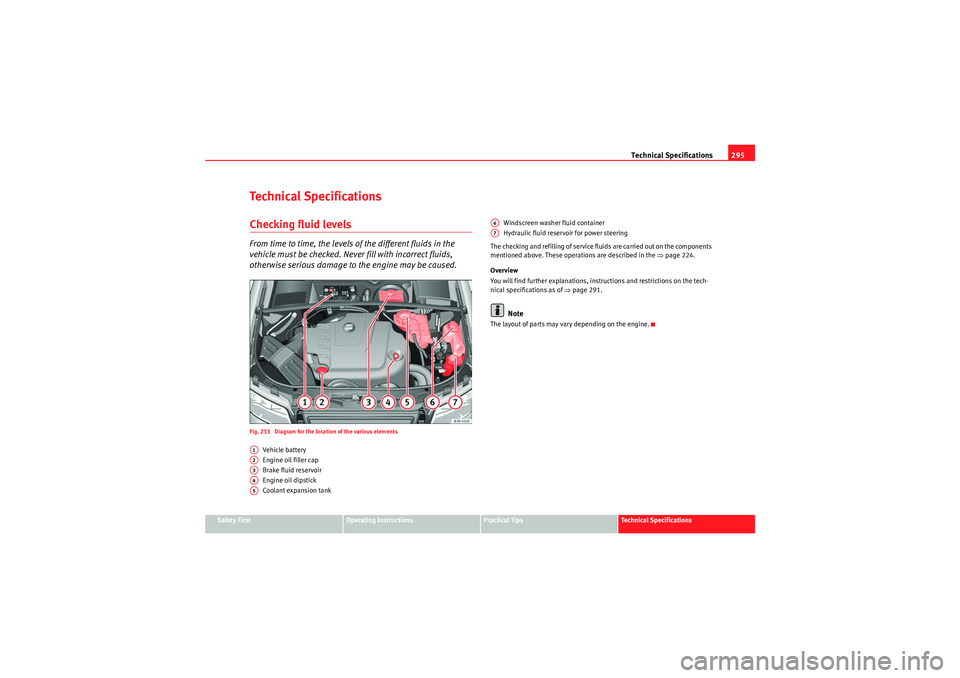
Technical Specifications295
Safety First
Operating Instructions
Practical Tips
Technical Specifications
Technical SpecificationsChecking fluid levelsFrom time to time, the levels of the different fluids in the
vehicle must be checked. Never fill with incorrect fluids,
otherwise serious damage to the engine may be caused.Fig. 233 Diagram for the location of the various elements
Vehicle battery
Engine oil filler cap
Brake fluid reservoir
Engine oil dipstick
Coolant expansion tank Windscreen washer fluid container
Hydraulic fluid reservoir for power steering
The checking and refilling of service fluids are carried out on the components
mentioned above. These operations are described in the ⇒page 224.
Overview
You will find further explanations, instructions and restrictions on the tech-
nical specifications as of ⇒page 291.
Note
The layout of parts may vary depending on the engine.
A1A2A3A4A5
A6A7
exeo_EN.book Seite 295 Montag, 30. August 2010 4:45 16
Page 299 of 319
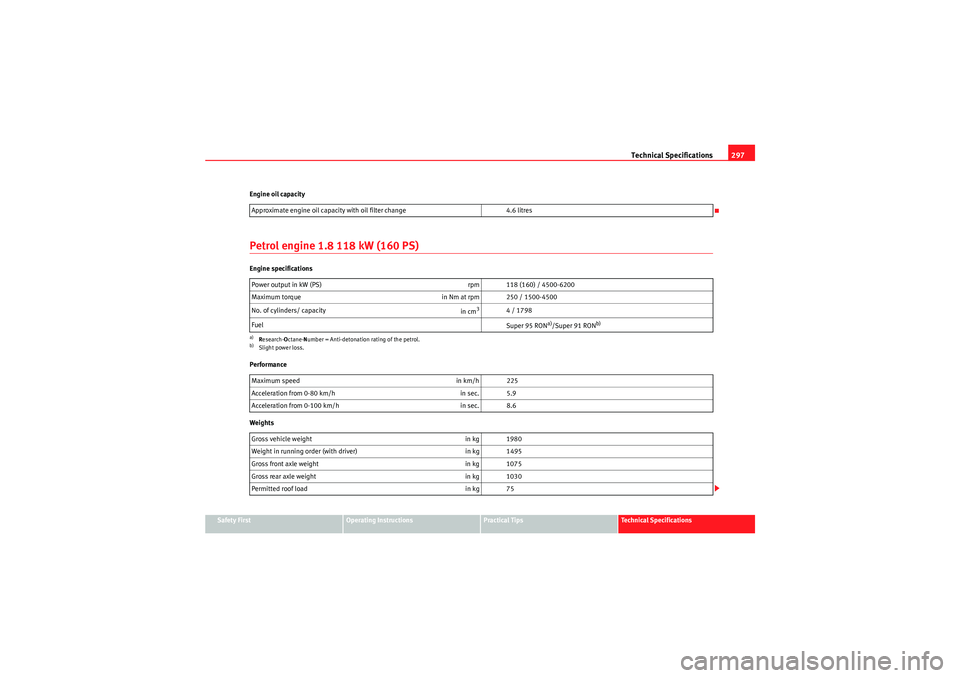
Technical Specifications297
Safety First
Operating Instructions
Practical Tips
Technical Specifications
Engine oil capacity
Petrol engine 1.8 118 kW (160 PS)Engine specifications
Performance
Weights
Approximate engine oil capacity with oil filter change
4.6 litres
Power output in kW (PS) rpm 118 (160) / 4500-6200
Maximum torque in Nm at rpm 250 / 1500-4500
No. of cylinders/ capacity in cm
3
4 / 1798
Fuel Super 95 RON
a)/Super 91 RON
b)
a)Research- Octane- Number = Anti-detonation rating of the petrol.b)Slight power loss.Maximum speed in km/h 225
Acceleration from 0-80 km/h in sec. 5.9
Acceleration from 0-100 km/h in sec. 8.6
Gross vehicle weight in kg 1980
Weight in running order (with driver) in kg 1495
Gross front axle weight in kg 1075
Gross rear axle weight in kg 1030
Permitted roof load in kg 75
exeo_EN.book Seite 297 Montag, 30. August 2010 4:45 16
Page 300 of 319

Technical Specifications
298Trailer weight
Engine oil capacityPetrol engine 2.0 147 kW (200 PS)Engine specifications
Performance Trailer without brakes
740
Trailer with brakes, gradients up to 8% 1600
Trailer with brakes, gradients up to 12% 1400
Approximate engine oil capacity with oil filter change 4.6 litres
Power output in kW (PS) rpm 147 (200) / 5100-6000
Maximum torque in Nm at rpm 280 / 1800-5000
No. of cylinders/ capacity in cm
3
4 / 1984
Fuel Super 98 RON
a)/Super 95 RON
b)
a)Research- Octane- Number = Anti-detonation rating of the petrol.b)Slight power loss.
Manual Automatic
Maximum speed in km/h 241235
Acceleration from 0-80 km/h in sec. 5.45.3
Acceleration from 0-100 km/h in sec. 7.37.3
exeo_EN.book Seite 298 Montag, 30. August 2010 4:45 16
Page 301 of 319
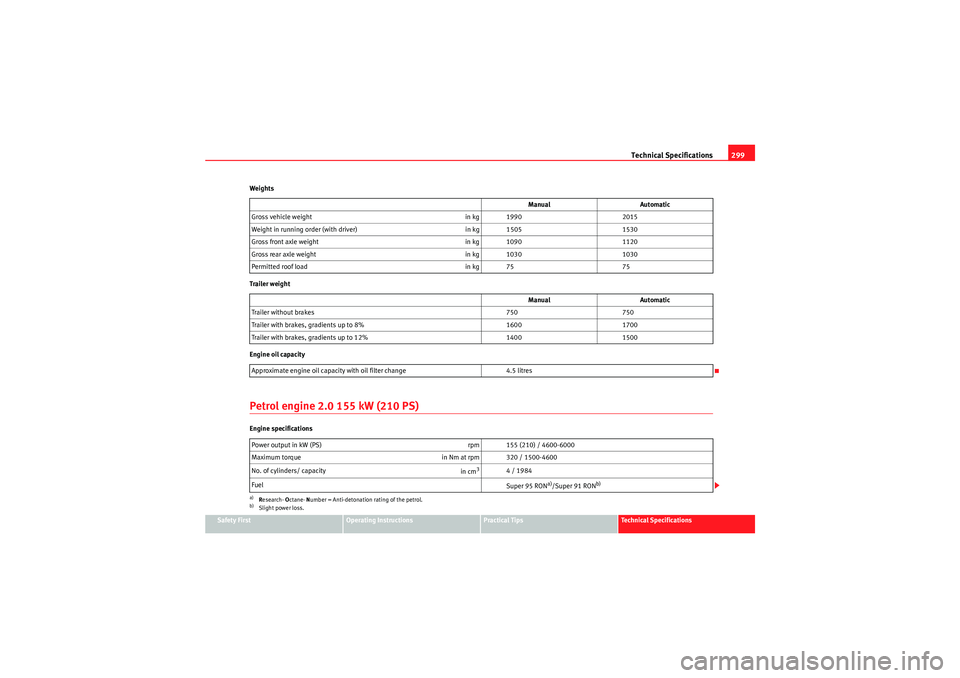
Technical Specifications299
Safety First
Operating Instructions
Practical Tips
Technical Specifications
Weights
Trailer weight
Engine oil capacity
Petrol engine 2.0 155 kW (210 PS)Engine specifications
Manual
Automatic
Gross vehicle weight in kg 19902015
Weight in running order (with driver) in kg 15051530
Gross front axle weight in kg 10901120
Gross rear axle weight in kg 10301030
Permitted roof load in kg 7575
Manual Automatic
Trailer without brakes 750750
Trailer with brakes, gradients up to 8% 16001700
Trailer with brakes, gradients up to 12% 14001500
Approximate engine oil capacity with oil filter change 4.5 litres
Power output in kW (PS) rpm 155 (210) / 4600-6000
Maximum torque in Nm at rpm 320 / 1500-4600
No. of cylinders/ capacity in cm
3
4 / 1984
Fuel Super 95 RON
a)/Super 91 RON
b)
a)Research- Octane- Number = Anti-detonation rating of the petrol.b)Slight power loss.
exeo_EN.book Seite 299 Montag, 30. August 2010 4:45 16
Page 302 of 319

Technical Specifications
300Performance
Weights
Trailer weight
Engine oil capacity Maximum speed
in km/h 244
Acceleration from 0-80 km/h in sec. 5.3
Acceleration from 0-100 km/h in sec. 7.1
Gross vehicle weight in kg 1990
Weight in running order (with driver) in kg 1505
Gross front axle weight in kg 1090
Gross rear axle weight in kg 1030
Permitted roof load in kg 75
Trailer without brakes 750
Trailer with brakes, gradients up to 8% 1700
Trailer with brakes, gradients up to 12% 1500
Approximate engine oil capacity with oil filter change 4.6 litres
exeo_EN.book Seite 300 Montag, 30. August 2010 4:45 16
Page 304 of 319

Technical Specifications
302Engine oil capacityDiesel engine 2.0 TDI CR 105 kW (143 PS)Engine specifications
Performance
Weights Approximate engine oil capacity with oil filter change
4.3 litres
Power output in kW (PS) rpm 105 (143) / 4200
Maximum torque in Nm at rpm 320 / 1750-2500
No. of cylinders/ capacity in cm
3
4 / 1968
Fuel Min. 51 CN
a)
a)Cetane- Number (cetane index) = Measure of the combustion power of the dieselMaximum speed in km/h 215
Acceleration from 0-80 km/h in sec. 6.3
Acceleration from 0-100 km/h in sec. 9.2
Gross vehicle weight in kg 1990
Weight in running order (with driver) in kg 1505
Gross front axle weight in kg 1100
Gross rear axle weight in kg 1015
Permitted roof load in kg 75
exeo_EN.book Seite 302 Montag, 30. August 2010 4:45 16
Page 305 of 319
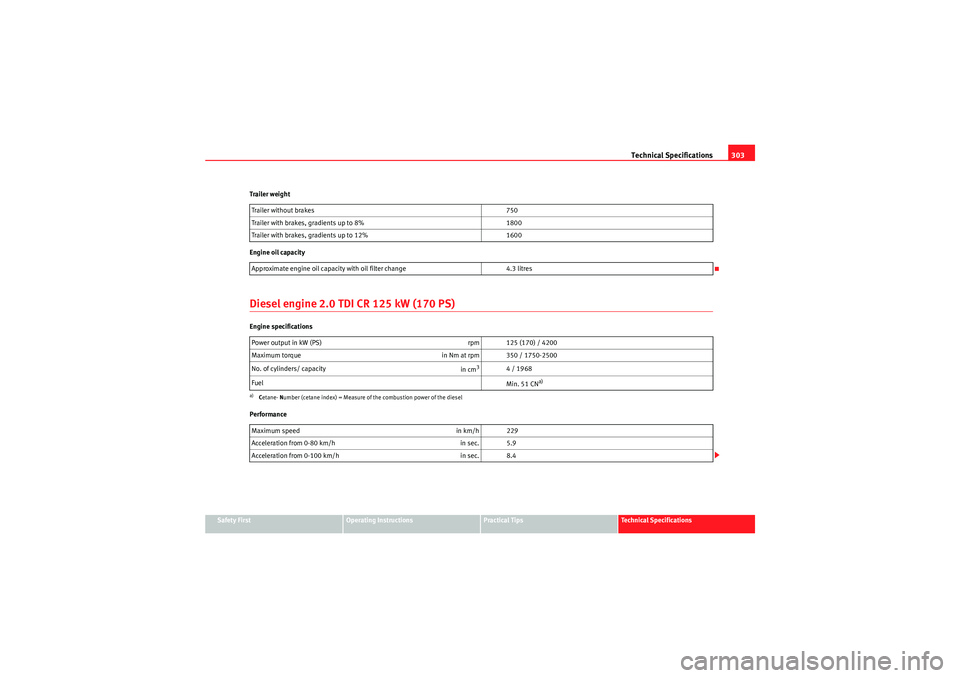
Technical Specifications303
Safety First
Operating Instructions
Practical Tips
Technical Specifications
Trailer weight
Engine oil capacity
Diesel engine 2.0 TDI CR 125 kW (170 PS)Engine specifications
Performance
Trailer without brakes
750
Trailer with brakes, gradients up to 8% 1800
Trailer with brakes, gradients up to 12% 1600
Approximate engine oil capacity with oil filter change 4.3 litres
Power output in kW (PS) rpm 125 (170) / 4200
Maximum torque in Nm at rpm 350 / 1750-2500
No. of cylinders/ capacity in cm
3
4 / 1968
Fuel Min. 51 CN
a)
a)Cetane- Number (cetane index) = Measure of the combustion power of the dieselMaximum speed in km/h 229
Acceleration from 0-80 km/h in sec. 5.9
Acceleration from 0-100 km/h in sec. 8.4
exeo_EN.book Seite 303 Montag, 30. August 2010 4:45 16